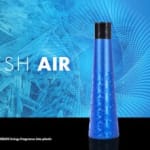
Plastics that smell good - what sounds like a vision of the future is currently being put into practice in a development project at Grafe, with its headquarters in Blankenhain. The first result is a masterbatch for PP, which releases a scent by means of a fragrance-active substance. "The principle is based on the migration of the fragrance to the surface, the rate depends on the kind of plastic, whereby the process is slowed down prolonging the releasing effect," explains Lars Schulze, Team Leader Material Science. Thus, the fragrance release show a good effect in polyolefins such as PP, PE and other flexible polymers such as TPU.
In the gentle manufacturing process used by Grafe, the masterbatch is exceptionally highly concentrated with one oil. Nevertheless, the masterbatch remains conveyable and can be used normally at a dosage of between one and three percent. Depending on the carrier polymer, the transparency can be maintained. "The duration of the fragrance release depends on the type of application, plastic, ambient temperature and constant supply of fresh air," says the expert. He refers to four-month-old samples in PP that would still provide a pleasant smell. Initial tests have shown that even colouring does not significantly influence the scent release, he reports.
According to Schulze, there are at the moment hardly any similar applications on the market.
The direct integration of the scents into functional components such as switches, buttons or trim components is an innovation, because until now, scents in combination with plastics have been commonly used within in packaging and marketing. In the current project, which has been running since the beginning of 2021, a fragrance masterbatch was created that provides the feeling of a freshly cleaned bathroom and therefore bears the name "Fresh Air". But the range of possible applications is huge, he says, offering a wide range of fragrance oils. "Whether classic bathroom hygiene, motorway WCs, urinals, push-buttons for flushes or showers. In the public sanitary sector alone, the possibilities are almost unlimited," the team leader for Material Science lists a few examples.
But that’s not all: applications in the direction of wood and leather are also conceivable. "Both raw materials are increasingly being substituted for environmental & sustainability reasons, animal protection or vegan way of life. That’s why WPC (wood plastic compounds) that embody a pleasant wood scent or a realistic leather imitation are exciting ideas," says Schulze. Artificial Christmas trees that smell like fir or pine are also an interesting field of application. In the automotive industry, steering wheels or dashboards from which fragrant scents migrate could be implemented. Applications in the furniture industry are also possible. "Bedroom furniture that provides a soothing lavendel scent or kitchen furniture that exudes a lemon scent - the variety is virtually limitless."
In addition to optics and haptics, the fragrance masterbatches offer to clients within the consumer goods industry a third possibility to estimulate our sense of smell, namely olfaction, the expert describes he market opportunities of the development. Moreover, the topic of scents and smells could be excellently combined with Grafe’s core competence - the coloring of plastics. "A yellow that smells like fresh lemon or a green that gives off the scent of mint can be marketed excellently," says Schulze and points to another advantage: "With our fragrance concentrates, bad smells are targeted and supressed."
Grafe has been working on the topic of fragrance paints for about two years and is conducting the corresponding tests. The current development is intended to be the initial spark to attract further project partners. Schulze explains that there are still a few hurdles to overcome. "Temperature stability is just as much a challenge as flame retardancy and mechanical stability," says the expert. In addition, strict hygiene requirements in the medical technology, packaging and food industries make implementation difficult.



